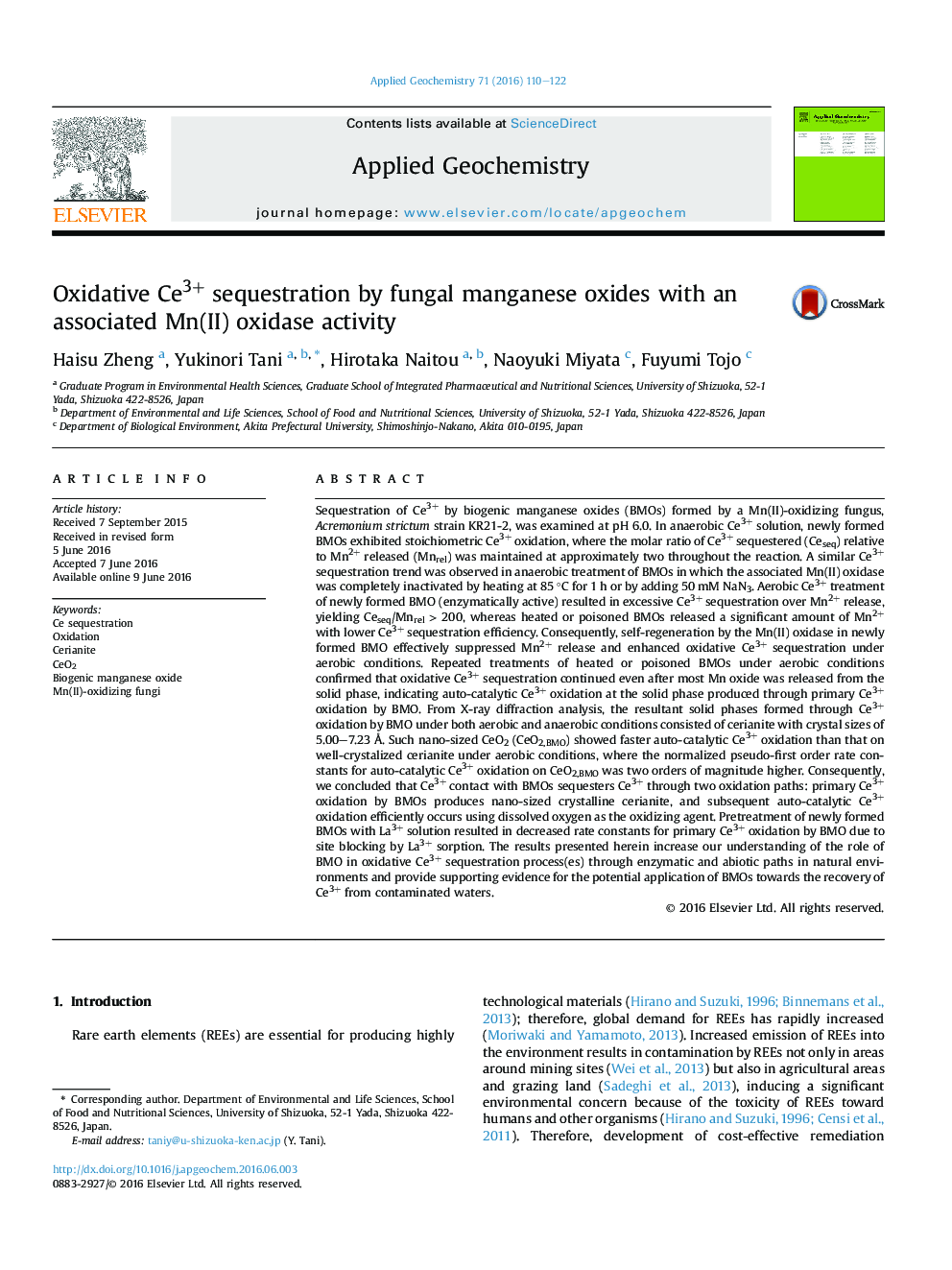| کد مقاله | کد نشریه | سال انتشار | مقاله انگلیسی | نسخه تمام متن |
|---|---|---|---|---|
| 4435563 | 1620220 | 2016 | 13 صفحه PDF | دانلود رایگان |

• Biogenic Mn oxides (BMOs) readily sequester Ce3+.
• Self-regeneration by an associated Mn(II) oxidase suppresses Mn2+ release.
• Primary Ce3+ oxidation by BMOs produces nano-sized cerianite (CeO2).
• Nano-sized CeO2 induces auto-catalytic oxidation of Ce3+ by dissolved oxygen.
• Coexisting La3+ slows Ce3+ oxidation rate by blocking of the reaction sites.
Sequestration of Ce3+ by biogenic manganese oxides (BMOs) formed by a Mn(II)-oxidizing fungus, Acremonium strictum strain KR21-2, was examined at pH 6.0. In anaerobic Ce3+ solution, newly formed BMOs exhibited stoichiometric Ce3+ oxidation, where the molar ratio of Ce3+ sequestered (Ceseq) relative to Mn2+ released (Mnrel) was maintained at approximately two throughout the reaction. A similar Ce3+ sequestration trend was observed in anaerobic treatment of BMOs in which the associated Mn(II) oxidase was completely inactivated by heating at 85 °C for 1 h or by adding 50 mM NaN3. Aerobic Ce3+ treatment of newly formed BMO (enzymatically active) resulted in excessive Ce3+ sequestration over Mn2+ release, yielding Ceseq/Mnrel > 200, whereas heated or poisoned BMOs released a significant amount of Mn2+ with lower Ce3+ sequestration efficiency. Consequently, self-regeneration by the Mn(II) oxidase in newly formed BMO effectively suppressed Mn2+ release and enhanced oxidative Ce3+ sequestration under aerobic conditions. Repeated treatments of heated or poisoned BMOs under aerobic conditions confirmed that oxidative Ce3+ sequestration continued even after most Mn oxide was released from the solid phase, indicating auto-catalytic Ce3+ oxidation at the solid phase produced through primary Ce3+ oxidation by BMO. From X-ray diffraction analysis, the resultant solid phases formed through Ce3+ oxidation by BMO under both aerobic and anaerobic conditions consisted of cerianite with crystal sizes of 5.00–7.23 Å. Such nano-sized CeO2 (CeO2,BMO) showed faster auto-catalytic Ce3+ oxidation than that on well-crystalized cerianite under aerobic conditions, where the normalized pseudo-first order rate constants for auto-catalytic Ce3+ oxidation on CeO2,BMO was two orders of magnitude higher. Consequently, we concluded that Ce3+ contact with BMOs sequesters Ce3+ through two oxidation paths: primary Ce3+ oxidation by BMOs produces nano-sized crystalline cerianite, and subsequent auto-catalytic Ce3+ oxidation efficiently occurs using dissolved oxygen as the oxidizing agent. Pretreatment of newly formed BMOs with La3+ solution resulted in decreased rate constants for primary Ce3+ oxidation by BMO due to site blocking by La3+ sorption. The results presented herein increase our understanding of the role of BMO in oxidative Ce3+ sequestration process(es) through enzymatic and abiotic paths in natural environments and provide supporting evidence for the potential application of BMOs towards the recovery of Ce3+ from contaminated waters.
Figure optionsDownload as PowerPoint slide
Journal: Applied Geochemistry - Volume 71, August 2016, Pages 110–122